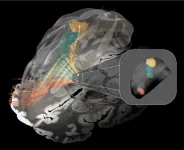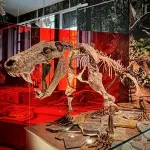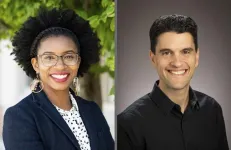(Press-News.org) When certain connections in the brain do not function correctly, disorders such as Parkinson’s disease, dystonia, obsessive-compulsive disorder (OCD), and Tourette’s syndrome may result. Targeted stimulation of specific areas in the brain can help alleviate symptoms. To pinpoint the exact therapeutic target areas of the brain, a team led by researchers from Charité – Universitätsmedizin and Brigham and Women’s Hospital analyzed data from patients across the globe who had undergone implantation of tiny electrodes to stimulate the brain. The result is a unique map of disrupted brain networks that has now been published in Nature Neuroscience.*
Neurological and neuropsychiatric disorders present with a broad spectrum of different symptoms, from mood and information processing disorders to motor deficits. But they do have one thing in common: They are all attributable to malfunctioning connections between specific regions of the brain. In simplified terms, when brain circuits become dysfunctional, they may act as brakes on the brain functions that the circuit usually carries out.
Deep brain stimulation (DBS) targets these kinds of malfunctional circuits and can be instrumental in alleviating symptoms in various areas. In this neurosurgical approach, small electrodes are implanted into precisely defined target brain areas. The electrodes then chronically emit weak electrical pulses to the surrounding tissue. The stimulation effects travel along neural pathways to more distant areas of the brain to unfold their full impact. But stimulation is not always successful. Even small discrepancies in electrode placement can lead to weaker effects of the treatment.
Which specific brain circuits need to be stimulated to achieve optimal outcomes when treating a range of symptoms was the question for an international team headed by neuroscientists Prof. Andreas Horn and Dr. Ningfei Li at Charité and Brigham and Women’s Hospital. “Our goal was to better understand where in the brain possible ‘brakes’ can be released through neuromodulation to normalize the symptoms of Parkinson’s disease, for example,” says Ningfei Li.
Exploring a seeming paradox
The researchers’ work addresses a seeming paradox that has been known for a while in this field. A specific area of the basal ganglia called the subthalamic nucleus is considered an effective target for DBS to treat the symptoms of Parkinson’s disease and dystonia, which are both on the spectrum of movement disorders. Recently, the same region of the brain was also identified as a successful target for treating neuropsychiatric disorders such as OCD and tic disorders.
This raised the question of how such a small nucleus, only about one centimeter long, could be an effective target for symptoms of such different brain dysfunctions. To investigate this question, the team analyzed data from 534 DBS electrodes implanted in 261 patients across the globe. Of this cohort, 70 patients were diagnosed with dystonia, 127 with Parkinson’s disease, 50 with OCD, and 14 with Tourette’s syndrome. Using software developed by the team, the researchers reconstructed the precise location of each electrode. Computer simulations were then used to map neural tracts that were activated in patients with optimal or suboptimal treatment outcomes.
Using these results, they were able to identify specific brain circuits that had become dysfunctional in each of the four disorders. They were associated with the relevant regions of the frontal part of the brain that play an important role in motor functions, impulse control, and information processing. “The circuits we identified partially overlapped, which to us implies that the malfunctions reflected in the symptoms studied are not wholly independent from each other,” says Barbara Hollunder, a PhD fellow at the Einstein Center for Neurosciences at Charité and the first author of the study.
This means that as the first step, the researchers have succeeded in localizing the exact networks in the forebrain and midbrain that are crucial to treating Parkinson’s disease, dystonia, obsessive-compulsive disorder, and Tourette’s syndrome. Applying this same approach across disorders with different symptoms gradually yields a map that denotes how specific brain circuits are associated with certain symptoms. “By analogy to the terms ‘connectome,’ which describes a comprehensive map of all neural connections existing in the brain, and ‘genome,’ which is used for the full set of genetic information found in an organism, we have coined the term human ‘dysfunctome.’ One day, we hope the dysfunctome will describe the entirety of brain circuits that may typically become dysfunctional as a result of network disorders,” Hollunder explains.
Initial success with treatment in the course of the study
The researchers’ findings have already benefited the first few patients. Fine-tuning and precision electrode placement made it possible to alleviate the symptoms of severe, treatment-resistant OCD, for example. “We plan to refine this technique and zero in even more precisely on dysfunctional brain circuits for specific symptoms. For example, we could isolate the circuits involved in obsessions or compulsions in OCD, or other comorbid symptoms commonly found in these patients, like depression and anxiety disorders, to individualize treatment further,” says Ningfei Li, looking to the future.
The researchers also believe that more than one region of the brain may be responsible for improvement of a given symptom. They suspect that neural networks themselves transmit the therapeutic effects, which can be modulated from various points in the brain. This means the study provides not only valuable insights for targeted neurosurgical treatment, but may also inspire approaches for noninvasive neuromodulation such as transcranial magnetic stimulation (TMS), in which magnetic fields are used to stimulate certain areas of the brain from outside of the brain, without the need for surgery.
*Hollunder, Barbara et al. Mapping Dysfunctional Circuits in the Frontal Cortex Using Deep Brain Stimulation. Nature Neuroscience 2024. Feb 22. doi: 10.1038/s41593-024-01570-1
A summary of the article has also been published by Nature Neuroscience as a research briefing: Hollunder, Barbara & Horn, Andreas. Mapping the dysfunctome provides an avenue for targeted brain circuit therapy. Nature Neuroscience 2024. Feb 22.
About the study
Researchers at ten specialized centers in seven countries provided data for the study and contributed to the findings. The work received support from the Einstein Center for Neurosciences Berlin (ECN), the Berlin Institute of Health at Charité (BIH), the Benign Essential Blepharospasm Research Foundation, private supporters Larry and Kana Miao, the Agence nationale de la recherche, the NIHR UCLH Biomedical Research Centre, Scuola Superiore Sant'Anna, the German Research Foundation (DFG), the German Aerospace Center (DLR), the Else Kröner-Fresenius-Stiftung, the Italian Ministry of Health, the Medical Research Council UK, the National Institutes of Health (NIH), and the New Venture Fund.
Links
Original publication
Department of Neurology with Experimental Neurology
Movement Disorders and Neuromodulation Unit (in German)
END
Releasing “brakes” in the brain
Researchers use deep brain stimulation to localize disrupted neural pathways
2024-02-22
ELSE PRESS RELEASES FROM THIS DATE:
JMIR Publications celebrates 25 years of publishing health research
2024-02-22
Join Gunther Eysenbach, the founder, CEO, and executive editor of JMIR Publications, in this new video as he reflects on the company's 25th anniversary and its remarkable journey in the scholarly publishing industry. Eysenbach discusses the inception of the Journal of Medical Internet Research and the driving forces behind creating an open access eHealth journal. He emphasizes the significance of innovation both in content and form, highlighting the company's early adoption of internet-based technologies ...
How discrimination, class, and gender intersect to affect Black Americans’ well-being
2024-02-22
URBANA, Ill. – Black Americans experience racial discrimination as a chronic stressor that influences their quality of life. But it exists in conjunction with other social factors that may modify the impact in various ways. A new study from the University of Illinois Urbana-Champaign explores how discrimination, gender, and social class affect individual well-being and relationship quality for Black Americans.
“It’s well documented that discrimination negatively impacts individual quality of life, but research on how it affects relationships is mixed. Some studies find it has a negative effect, others that it has no effect, and some even find a positive effect, ...
Compound vital for all life likely played a role in life’s origin
2024-02-22
Compound vital for all life likely played a role in life’s origin
A chemical compound essential to all living things has been synthesised in a lab in conditions that could have occurred on early Earth, suggesting it played a role at the outset of life, finds a new study led by UCL researchers.
The compound, pantetheine, is the active fragment of Coenzyme A. It is important for metabolism - the chemical processes that maintain life. Earlier studies failed to synthesise pantetheine effectively, leading to suggestions that it was absent at life’s origin.
In the new ...
Study reveals new insights into immune system role in lung cancer risk
2024-02-22
New York, NY (February 22, 2024)—Recent developments in cancer research have highlighted the vital role of the immune system, particularly in the notable successes of cancer immunotherapy.
Now, a paradigm-shifting study led by researchers at the Icahn School of Medicine at Mount Sinai in New York in collaboration with the University of Helsinki and Massachusetts General Hospital sheds light on how variations in immune genetics influence lung cancer risk, potentially paving the way for enhanced prevention strategies and screening.
The findings were described in the February 22 online issue of Science [DOI number: 10.1126/science.adi3808].
The investigators ...
New Cedars-Sinai study pinpoints why some injured kidneys do not heal
2024-02-22
Cedars-Sinai investigators have discovered why some injured kidneys heal while others develop scarring that can lead to kidney failure. Their findings, detailed in a paper published in the peer-reviewed journal Science, could lead to the development of noninvasive tests to detect kidney scarring and, eventually, new therapies to reverse the condition.
“The key to this discovery was our ability to directly compare injured kidney cells that successfully regenerated with those that did not,” said Sanjeev Kumar, MD, PhD, a nephrologist-scientist in the Board of Governors Regenerative Medicine Institute and the Department of Medicine at Cedars-Sinai and senior author ...
Moving “beyond Mendel” in genetics education can reduce racism, new study suggests
2024-02-22
Data from a series of randomized trials in the United States suggests that if teachers move genetics instruction toward more complex genomics concepts, they can help students have a more scientifically accurate understanding of race. This can protect students from believing in unscientific notions of genetic essentialism, including the idea that inequality is genetic. People who believe in genetic essentialism believe – among other ideas – that most racial differences are determined by genes. Essentialist ...
Uncovered with JWST: A neutron star in the remnant of Supernova 1987A
2024-02-22
Astronomers using the James Webb Space Telescope (JWST) have found conclusive evidence of a neutron star in the remnant of Supernova 1987A, the only supernova visible to the naked eye in the last 400 years and the most studied supernova in history. Although Supernova 1987A has been observed for more than three decades, scientists have not seen the compact object expected to have been produced during the explosion. Some indirect evidence had suggested that the supernova produced a neutron star, but a black hole wasn’t ruled ...
Chemistry and albedo feedbacks offset forestation’s net climate benefits
2024-02-22
Roughly a third of the climate cooling that forests achieve by removing carbon dioxide (CO2) from the atmosphere is offset through changes to atmospheric composition and decreased surface reflectivity, researchers report. The findings suggest that the benefits of wide-scale forestation efforts may be overestimated and do not represent a single solution for addressing climate change. They also highlight the urgency of simultaneously focusing on emissions reductions. Planting trees has been widely promoted as a nature-based solution to remove anthropogenic CO2 from the atmosphere to help mitigate ...
Snakes do it faster, better: How a group of scaly, legless lizards hit the evolutionary jackpot
2024-02-22
More than 100 million years ago, the ancestors of the first snakes were small lizards that lived alongside other small, nondescript lizards in the shadow of the dinosaurs.
Then, in a burst of innovation in form and function, the ancestors of snakes evolved legless bodies that could slither across the ground, highly sophisticated chemical detection systems to find and track prey, and flexible skulls that enabled them to swallow large animals.
Those changes set the stage for the spectacular diversification of snakes over the past 66 million years, allowing them to quickly exploit new opportunities ...
Side effects of wide scale forestation could reduce carbon removal benefits by up to a third
2024-02-22
The side effects of large-scale forestation initiatives could reduce the CO2 removal benefits by up to a third
Researchers at the University of Sheffield used computer models, which simulate the land, ocean and atmosphere, to investigate the impact of forestation under future climate scenarios
While forestation increases atmospheric CO2 removal, it also changes atmospheric composition and darkens the land surface, reducing its potential to tackle climate change
Combining forestation with other climate mitigation ...
LAST 30 PRESS RELEASES:
Scientists discover first method to safely back up quantum information
A role for orange pigments in birds and human redheads
Pathways to net-zero greenhouse gas emissions for Southeast Asia
A JBNU–KIMS collaborative study on a cost-effective alloy matches superalloys for power plants and energy infrastructure
New study overturns long-held model of how plants coordinate immune responses.
New AI model predicts disease risk while you sleep
Scientists discover molecular ‘reshuffle’ and crack an 80-year-old conundrum
How stressors during pregnancy impact the developing fetal brain
Electrons lag behind the nucleus
From fungi to brain cells: one scientist's winding path reveals how epigenomics shapes neural destiny
Schizophrenia and osteoporosis share 195 genetic loci, highlighting unexpected biological bridges between brain and bone
Schizophrenia-linked genetic variant renders key brain receptor completely unresponsive to both natural and therapeutic compounds
Innovative review reveals overlooked complexity in cellular energy sensor's dual roles in Alzheimer's disease
Autism research reframed: Why heterogeneity is the data, not the noise
Brazil's genetic treasure trove: supercentenarians reveal secrets of extreme human longevity
The (metabolic) cost of life
CFRI special issue call for papers: New Frontiers in Sustainable Finance
HKU Engineering scholar demonstrates the smallest all-printed infrared photodetectors to date
Precision empowerment for brain "eavesdropping": CAS team develops triple-electrode integrated functional electrode for simultaneous monitoring of neural signals and chemical transmitters during sleep
Single-capillary endothelial dysfunction resolved by optoacoustic mesoscopy
HKU three research projects named among ‘Top 10 Innovation & Technology News in Hong Kong 2025’ showcasing excellence in research and technology transfer
NLRSeek: A reannotation-based pipeline for mining missing NLR genes in sequenced genomes
A strand and whole genome duplication–aware collinear gene identification tool
Light storage in light cages: A revolutionary approach to on-chip quantum memories
Point spread function decoupling in computational fluorescence microscopy
BacPhase: Long-insert paired-end sequencing for bin marker construction and genome phasing
GmWOX1 regulates the mediolateral polarity of compound leaves in soybean
ChargeFabrica: An open-source simulation tool that aims to accelerate search for high performance perovskite solar cells
High levels of ADAR overexpression induce abundant and stochastic off-target RNA editing in rice protoplasts
On-demand upgraded recycling of polyethylene and construction of sustainable multifunctional materials based on the "LEGO" strategy
[Press-News.org] Releasing “brakes” in the brainResearchers use deep brain stimulation to localize disrupted neural pathways





